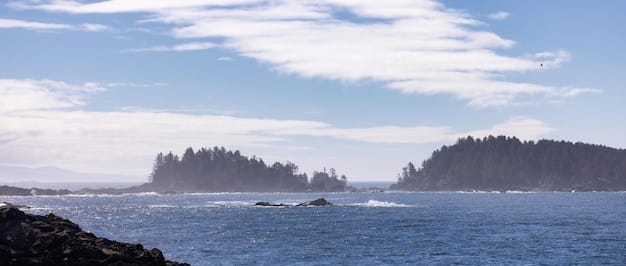Wave Energy Conversion Advancements in US Coastal Regions

Wave energy conversion (WEC) technology has seen significant advancements in recent years, particularly in the US coastal regions, driven by the need for sustainable and renewable energy sources.
As the demand for renewable energy sources intensifies, exploring innovative technologies like wave energy conversion becomes crucial. Recent advancements in wave energy conversion technology for US coastal regions are paving the way for more efficient and sustainable energy solutions.
Understanding Wave Energy Conversion Technology
Wave energy conversion (WEC) technology is designed to capture the kinetic energy of ocean waves and convert it into electricity. This process harnesses the natural power of waves, offering a sustainable alternative to traditional fossil fuels.
The basic principle involves deploying devices that can interact with the motion of the waves. As waves pass, these devices move, and this mechanical movement is then converted into electrical energy. There are various types of WEC devices, each designed to operate in different wave conditions and coastal environments.
Types of Wave Energy Converters
Several types of wave energy converters are being developed and tested around the world. Each type has its own advantages and is suited for different coastal conditions. Understanding these variations is crucial for effective deployment.
- Oscillating Water Columns (OWCs): These devices use the wave motion to compress air, which then drives a turbine to generate electricity.
- Point Absorbers: These devices float on the surface and use the relative motion between their parts to generate electricity.
- Overtopping Devices: These devices capture water from waves overtopping a reservoir, and then use the water’s potential energy to drive a turbine.
Each of these technologies is being refined to increase efficiency and reduce costs, making wave energy a more viable option for powering coastal communities.
In conclusion, wave energy conversion technology offers a promising avenue for generating clean electricity from ocean waves, with various device types each suited to different coastal environments.

Recent Advancements in Materials and Design
Advancements in materials science and engineering are significantly improving the performance and durability of wave energy converters. These innovations are leading to more efficient and reliable devices capable of withstanding harsh marine environments.
The use of advanced composite materials, such as carbon fiber and reinforced polymers, is becoming more common in WEC design. These materials offer high strength-to-weight ratios and are resistant to corrosion, a critical factor for devices operating in seawater.
Innovations in Device Design
Innovative designs are also playing a key role in enhancing the efficiency of wave energy converters. These designs focus on optimizing the interaction between the device and the waves, maximizing energy capture.
- Shape Optimization: Devices are being designed with specific shapes to better capture wave energy, increasing overall efficiency.
- Smart Control Systems: Advanced control systems are being implemented to adjust the device’s operation based on real-time wave conditions.
- Modular Designs: Modular wave energy converters are being developed to allow for scalability and easier maintenance.
These advancements are making wave energy converters more robust and efficient, paving the way for widespread adoption in coastal regions.
In summary, recent advancements in materials and design, including the use of advanced composites and innovative shapes, are improving the efficiency and durability of wave energy converters.
Integration with Smart Grids
Integrating wave energy converters with smart grids is essential for ensuring a reliable and efficient distribution of the generated electricity. Smart grids use advanced technologies to monitor and manage the flow of electricity, optimizing energy delivery.
Smart grid technologies enable wave energy to be integrated seamlessly with other renewable energy sources, such as solar and wind, creating a diversified and resilient energy portfolio. This integration helps to balance the intermittent nature of renewable energy sources, ensuring a stable power supply.
Benefits of Smart Grid Integration
Integrating wave energy with smart grids offers numerous benefits, including improved grid stability, reduced energy costs, and increased reliance on renewable energy sources.
- Enhanced Grid Reliability: Smart grids can quickly respond to fluctuations in wave energy output, ensuring a stable power supply.
- Cost Savings: By optimizing energy distribution, smart grids can reduce transmission losses and lower energy costs.
- Increased Renewable Energy Use: Smart grids facilitate the integration of wave energy with other renewable sources, reducing dependence on fossil fuels.
These benefits make smart grid integration a critical component of wave energy development in the US coastal regions.
In conclusion, integrating wave energy converters with smart grids is crucial for ensuring a reliable and efficient distribution of the generated electricity, leading to improved grid stability and reduced energy costs.

Environmental Impact Assessments and Mitigation Strategies
Thorough environmental impact assessments are essential for understanding and mitigating the potential ecological effects of wave energy converters. These assessments help to identify potential risks to marine life and coastal ecosystems.
Assessments typically involve studying the effects of WECs on marine habitats, fish populations, and marine mammals. The goal is to minimize any negative impacts and ensure that wave energy development is environmentally sustainable.
Mitigation Strategies
Various mitigation strategies are being developed and implemented to minimize the environmental impact of wave energy converters. These strategies focus on reducing noise pollution, minimizing habitat disturbance, and preventing entanglement of marine life.
- Noise Reduction Technologies: Implementing technologies to reduce the noise generated by WECs, minimizing disturbance to marine mammals.
- Habitat Protection Measures: Designing WEC deployments to minimize disruption to sensitive marine habitats.
- Entanglement Prevention: Incorporating designs that prevent marine life from becoming entangled in the devices.
These strategies are crucial for ensuring that wave energy development is environmentally responsible and sustainable.
In summary, environmental impact assessments and mitigation strategies are essential for minimizing the potential ecological effects of wave energy converters and ensuring sustainable development.
Economic Viability and Investment Opportunities
The economic viability of wave energy conversion technology is improving as costs decrease and efficiencies increase. This is creating new investment opportunities in the renewable energy sector.
Government incentives, tax credits, and research grants are playing a key role in supporting the development and deployment of wave energy converters. These financial incentives help to reduce the initial costs and make wave energy more competitive with traditional energy sources.
Investment Opportunities
Numerous investment opportunities are emerging in the wave energy sector, ranging from developing new technologies to deploying commercial-scale wave energy farms.
- Research and Development: Investing in research and development to improve the efficiency and reduce the costs of WECs.
- Commercial Deployment: Funding the deployment of commercial-scale wave energy farms in coastal regions.
- Infrastructure Development: Investing in the infrastructure needed to support wave energy projects, such as grid connections and maintenance facilities.
These investment opportunities are attracting interest from both private and public sectors, driving the growth of the wave energy industry.
In conclusion, the economic viability of wave energy conversion technology is improving, creating new investment opportunities in research, deployment, and infrastructure development.
Policy and Regulatory Framework in the US
The policy and regulatory framework in the US is evolving to support the development of wave energy conversion technology. Government agencies are working to establish clear guidelines for permitting, licensing, and environmental compliance.
The Department of Energy (DOE) and other federal agencies are collaborating to promote wave energy research and development. These efforts include funding research projects, conducting feasibility studies, and providing technical assistance to developers.
Key Regulations and Policies
Several key regulations and policies are shaping the development of wave energy in the US, including environmental protection laws, coastal zone management plans, and renewable energy standards.
- Environmental Protection Laws: Ensuring that wave energy projects comply with environmental protection laws, minimizing ecological impacts.
- Coastal Zone Management Plans: Integrating wave energy development into coastal zone management plans, promoting sustainable use of coastal resources.
- Renewable Energy Standards: Setting renewable energy standards that encourage the adoption of wave energy and other renewable sources.
These regulations and policies are creating a supportive framework for the growth of the wave energy industry in the US.
In summary, the policy and regulatory framework in the US is evolving to support the development of wave energy conversion technology, providing clear guidelines for permitting, licensing, and environmental compliance.
Future Outlook for Wave Energy in US Coastal Regions
The future outlook for wave energy in US coastal regions is promising, with continued advancements in technology, increasing investment, and supportive government policies. Wave energy is poised to play a significant role in the nation’s renewable energy future.
As technology improves and costs decrease, wave energy is expected to become an increasingly competitive source of clean energy. This will drive further adoption and deployment of wave energy converters along US coastlines.
Potential Benefits
Wave energy offers numerous potential benefits for US coastal regions, including energy security, economic development, and environmental sustainability.
- Energy Security: Reducing dependence on fossil fuels and diversifying the energy supply.
- Economic Development: Creating new jobs and industries in coastal communities.
- Environmental Sustainability: Reducing greenhouse gas emissions and promoting clean energy.
These benefits make wave energy a valuable resource for powering the future of US coastal regions.
In conclusion, the future outlook for wave energy in US coastal regions is bright, with continued advancements, increasing investment, and supportive policies paving the way for widespread adoption and deployment.
| Key Point | Brief Description |
|---|---|
| 🌊 Wave Energy | Harnessing ocean waves for clean electricity. |
| 💡 Material Advancements | Using composites for durability and efficiency. |
| ⚡ Smart Grids | Integrating wave energy for stable power. |
| 🛡️ Environmental Care | Assessing and reducing ecological impacts. |
Frequently Asked Questions
▼
Wave energy conversion is the process of capturing the kinetic energy of ocean waves and converting it into electricity. This renewable energy source offers a sustainable alternative to traditional fossil fuels.
▼
The main types include Oscillating Water Columns (OWCs), which use wave motion to compress air; Point Absorbers, which float and use relative motion; and Overtopping Devices, capturing water for potential energy.
▼
Environmental impacts are minimized through thorough assessments, noise reduction technologies, habitat protection measures, and designs preventing marine life entanglement, ensuring sustainable development.
▼
Smart grids are crucial for ensuring reliable and efficient distribution of electricity from wave energy converters, enhancing grid stability and reducing energy costs by optimizing energy delivery.
▼
The US policy framework supports wave energy development through clear guidelines for permitting, licensing, and environmental compliance, promoting research, development, and collaboration with federal agencies like the DOE.
Conclusion
In conclusion, the advancements in wave energy conversion technology offer a promising pathway for sustainable energy in US coastal regions. With ongoing developments in materials, design, and integration with smart grids, wave energy is poised to contribute significantly to a cleaner, more secure energy future.





